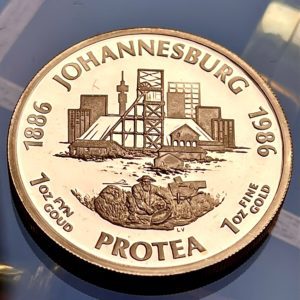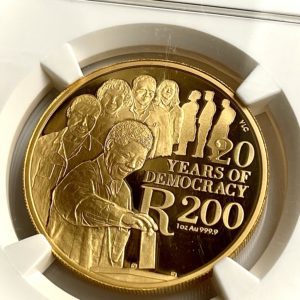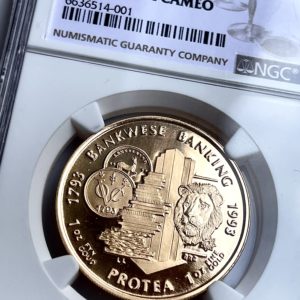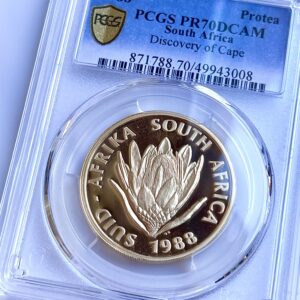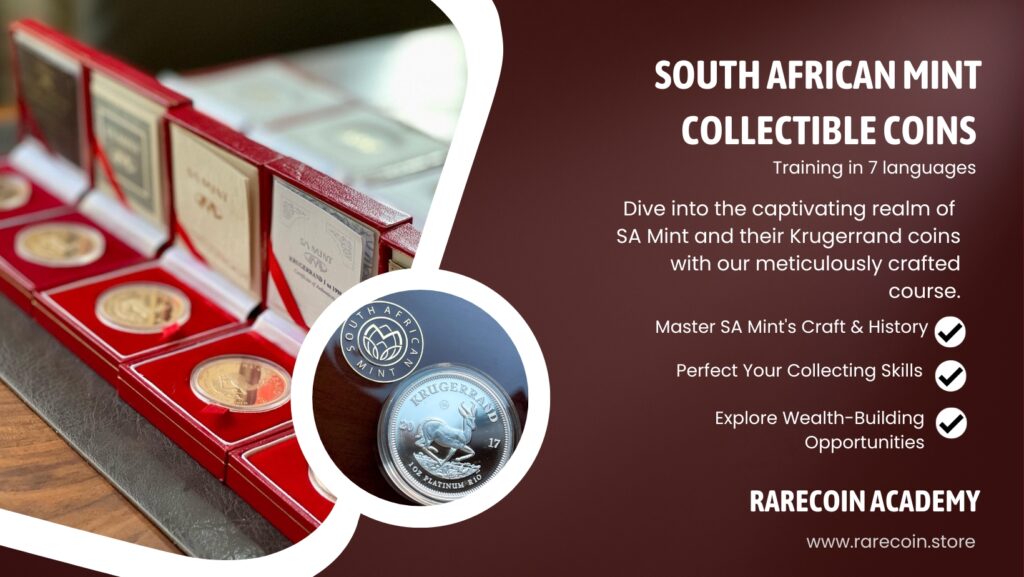
5.3. Protea gold coins: A brilliant interplay of art and history
The Protea gold coins represent an excellent fusion of art and history. The unique motifs designed specifically for each year are the true jewel of this coin collection. Let’s take a closer look at these magnificent coins together.
1986 – Johannesburg Centenary Protea, 1 oz
In 1986, the South African Mint released an exclusive limited edition Protea Gold Proof Coin to mark the centenary of the Great Gold Rush. For the first time, it was made from solid 22-karat gold weighing one ounce of pure gold. On the back there is a picture of a miner digging for gold in a stream. In the background you can see the headgear of a mine, sheds and a dump against the silhouette of modern Johannesburg. The front proudly displays the King Protea or King Sugar Bush, the national flower of South Africa. This exclusive edition is limited to a circulation of 4,701 pieces worldwide.
1988 Huguenot Commemorative Coin Protea 1 oz Gold
Front: Shows a fully bloomed protea.
Reverse: Within a frosted circle there is a symbolic representation of the Huguenot monument in Franschhoek, accompanied by the Trinity, the Huguenot cross and the dove, with the years 1688 on the left and 1988 on the right. The motif is incised and has a frosted border and frosted legends on the proof coins. The mintage of proof coins is limited to 3,391 pieces.
Additionally, two additional Protea gold coins were issued in 1988: the Dias Commemorative Protea (mintage: 3776) and the Great Trek Commemorative Protea (mintage: 2956), both weighing 1 ounce.
1991 – Nursing Commemorative Protea 1oz
On the reverse of the gold coin is an oil lamp (Aladdin’s magic lamp) in the middle of a cross. Around the oil lamp are engraved the years 1891 and 1991 to commemorate the existence of the South African Schools of Nursing. Around the motif you can see the inscription “Verpleging Protea Nursing”, “1 OZ Fyn Goud Fine Gold”. Edition: 3004.
1992 – Protea commemorative coin 1 oz, 100th anniversary of minting in South Africa
The reverse of four SA pounds or equivalent coins, clockwise from top: 1892 ZAR Pond, Sovereign (1923 issue), Two Rand (gold coin from 1961 to 1983) and the Two Rand (currently in use). There is an engraving “1892 Soli Deo Gloria 1992” and “1 OZ Fyn Goud Protea 1 OZ Fine Gold” around the motif on the back. Edition: 1752 only
1993 – South Africa – Protea – GRC – Banking Bicentennial – 1oz Gold
The front of the coin features the protea plant in the middle. This genus of plants, also known as sugar bushes, is typical of the silver tree family in South Africa. The plant is surrounded by the inscriptions “Suid – Africa”, “South Africa” and the year “1993”.
The reverse shows the South African Reserve Bank surrounded by coins and a lion’s head. The inscription “1793 Bankwese Banking 1993”, “1 OZ Fan Gold Protea 1 OZ Fine Gold” frames the motif. The coin was limited to 500 copies.
1994 – Conservation Commemorative Protea 1 oz – Protea 1 oz 1994 Big Five
This exclusive Protea 1 oz gold coin shows the Big Five animals from South Africa and was minted in 1994. There are only 1,187 copies of this rare piece in existence worldwide, making it particularly sought after by collectors and enthusiasts. Another highlight of this example is the certification by the NGC with the grade PR68UCAM (Ultra Cameo).
Front: The plant “Protea”, a typical silver tree of South Africa, takes up the middle of the front. It is surrounded by the inscriptions “Suid – Africa”, “South Africa” and the year “1994”.
Back: The inscription “1894 BEWARING PROTEA CONSERVATION 1994 1 oz Au” frames the motif of the Big Five – lion, leopard, elephant, buffalo and rhinoceros.
1995 – Railroad Commemorative Protea 1 oz
On the back the NZASM tunnel between Waterval Onder and Waterval Boven is shown. A cog railway steam locomotive leaves this tunnel and comes out of a symbolic cogwheel. The gear represents industry and at the same time a tunnel. The tracks extend over a bridge that symbolizes crossing international borders. The circulation is 694 copies.
1996 – The New South African Constitution (1994)
1996 – New South African Constitution. Back: An open book symbolizes South Africa’s new constitution from 1994. On the left is the Constitution logo, and an arm with one hand holds a pen for signing the Constitution book. Symbolic figures are depicted all around, representing the people of South Africa and their unity. The writing hand represents the people, whose unity is embodied in the figures depicted. The circulation is 987 copies.
1997 – South African “Women’s” Protea, 1 oz
Reverse: The face of a woman is depicted in front of the harsh South African landscape, which symbolizes Mother Earth and merges into Sister Moon. The various “PROTEA” letterings represent the numerous and sometimes contradictory challenges that women are confronted with throughout their lives. The coin has a mintage of 351 pieces.
1998 – “Year of the Child” Protea (Puzzle), 1 oz
Reverse: The coin shows a life puzzle that symbolizes the challenges and adventures that lie ahead for our children. The word “PROTEA” can be found on one of the puzzle blocks. The coin was minted in an edition of 298 pieces.
1999 – Protea Gold Miner (Mining in South Africa), 1 oz
The reverse of the coin depicts a miner working on a rock face deep in a mine. The image shows the daily challenges and hardships these brave men face in the dark and dank depths of South Africa’s mines. His face is one of concentration, and the glistening beads of sweat on his forehead are evidence of his hard work. The coin was minted in an edition of 253 pieces.
2000 – Protea Wine Industry (Vine Growing in South Africa), 1 oz
The reverse of the coin depicts a woman carrying a basket full of grapes against the backdrop of Table Mountain. The word “PROTEA” is engraved in the “Sea”. This coin was minted in an edition of 278 pieces.
2001 – Protea Tourism Industry (Tourism in South Africa), 1 oz
The reverse of the coin depicts a child playing on the beach with the majestic Table Mountain in the background. This coin was minted in a limited edition of 972 pieces.
2002 – Football Protea (Soccer) Bafana Bafana
The reverse of the coin shows fighting football players with the words “PROTEA R25” and “Bafana Bafana 1992-2002”. Bafana Bafana is the nickname of the South African men’s national football team and means “the boys, the boys” in Zulu. This coin was minted in an edition of 137 pieces.
2002 – World Summit On Sustainable Development, 1 oz
The reverse of the coin features a globe depicting the continent of Africa, accompanied by the inscription “PROSPERITY” and “R25 JOHANNESBURG WORLD SUMMIT 2002”. This coin was minted in a mintage of 421 pieces.
2003 – Cricket World Cup Protea, 1 oz
On the reverse: a batsman on one knee about to sweep the ball into leg. Edition: 210
2004 – Celebrating Ten Years of Democracy (Nelson Mandela), 1 oz
The reverse features a frontal bust of President Mandela, partially overlapping a side view. Part of the Union Buildings is shown below, and above it is a scroll with the years 1994 to 2004. The coin was minted individually in an edition of 5,000 pieces and an additional 1,000 pieces in sets.
Who was Nelson Mandela?
Nelson Mandela, also known as Madiba, was a central figure in South Africa’s history and played a crucial role in the fight against apartheid and the establishment of a multiracial democracy. Born on July 18, 1918, Mandela spent almost three decades of his life in prison fighting against the unjust apartheid regime. After his release in 1990, he was elected South Africa’s first black president and led the country from 1994 to 1999.
Mandela advocated for reconciliation and equality during his time in office and afterward. He was a symbol of peace and hope and dedicated his life to fighting for a more just and peaceful world. His legacy lives on in the hearts of many people, and he remains a source of inspiration for all who fight for freedom and equality. Nelson Mandela passed away on December 5, 2013, but his legacy and influence are as relevant today as they were during his lifetime.
2005 – Protea Series Honoring Chief Albert Luthuli, 1 oz
The reverse of the coin features a three-quarter view of Chief Albert Luthuli, the first black Nobel Peace Prize winner in 1960. On the left is the Freedon Chapter’s date of June 26, 1955, and on the right is its Nobel Prize year, 1960. His name and dates of life 1898-1967 are engraved below the image. This special edition has a mintage of 384 pieces and bears a special mint mark.
2006 – Protea Edition in honor of Archbishop Desmond Tutu, 1 oz
The reverse of the coin features a three-quarter view of the famous Archbishop Desmond Tutu. His signature can be seen above a cross. The denomination R25 is on the arms of the cross, while the year of his Nobel Prize award, 1984, runs vertically along the cross. The indication “999.9 AU” is positioned near the left edge. This coin issue has a mintage of 1,634 pieces.
2007 – Protea Edition Commemorating Nelson Mandela and Frederik Willem de Klerk, 1 oz
On the back there is a three-quarter view of Mandela and de Klerk, with the inscription “1993 Nobel Prize Winner” in the upper right area. In the left margin it says “1 oz 999.9 Au”. The coin issue has a circulation of 6,317 pieces.
Who was Frederik Willem de Klerk?
Frederik Willem de Klerk (1936 – 2021) was a prominent South African politician who served as the last president of the white minority government era from 1989 to 1994 and as deputy president from 1994 to 1996. He played a crucial role in the abolition of apartheid and the introduction of universal suffrage in South Africa.
2008 – Mahatma Gandhi Protea (Mahatma Gandhi), 1 oz
Front: Image of a protea flower with the caption: “SOUTH AFRICA 2008”. Reverse: depicting Gandhi in prayer position and the quote: “My life is my message”, followed by a R5 denomination, the name “Mahatma Gandhi” and his signature. Edition: 3023 pieces.
Who was Mahatma Gandhi?
Mahatma Gandhi, full name Mohandas Karamchand Gandhi (born October 2, 1869 in Porbandar, India; died January 30, 1948 in Delhi), was an Indian lawyer, politician, social activist and writer. He emerged as a key leader of the nationalist movement against British colonial rule in India.
2009 – South African National Anthem Protea (South African National Anthem), 1 oz
On the back, CJ Langenhoven and EM Sontonga are shown in three-quarter view, with staves in the middle. The circulation is 377 copies.
Who was CJ Langenhoven?
Cornelis Jacobus Langenhoven (1873 – 1932), known by his initials CJ Langenhoven, was a South African poet who contributed significantly to the development of Afrikaans literature and cultural history. His poems were an important part of the then young Afrikaans language. His best-known work is the lyrics to the South African national anthem “Die Stem van Suid-Afrika”, which was used during the apartheid era. Langenhoven was affectionately called “Sagmoedige Neelsie” or “Kerneels”. His childhood friend Hans Conrodius van Zyl played an important role in introducing Langenhoven to poetry.
Who was EM Sontonga?
Enoch Mankayi Sontonga (1873 – 1905) was a South African composer best known for the Xhosa anthem “Nkosi Sikelel’ iAfrika” (“God Bless Africa”). This anthem was adopted in an abridged form as the first half of the South African national anthem in 1994. Previously, it had been the official anthem of the African National Congress since 1925. “Nkosi Sikelel’ iAfrika” was also adopted by Zimbabwe and translated into the Shona language (“Ishe Komborera Afrika”) from 1980 to 1994.
2010 – Nobel Prize in Literature for Nadine Gordimer, 1 oz
The reverse of the coin features a portrait of Nadine Gordimer, surrounded by quotes from her works. The edition is 286 pieces.
Who what Nadine Gordimer?
Nadine Gordimer (20 November 1923 – 13 July 2014) was a South African author and political activist who was awarded the Nobel Prize for Literature in 1991.
In her works, Gordimer primarily addressed moral and racial questions, particularly in relation to apartheid in South Africa. Under this regime, some of her works, including Burger’s Daughter and July’s People, were banned. Gordimer actively campaigned against apartheid, joining the banned African National Congress and supporting Nelson Mandela in drafting his defense speech in 1964, which ultimately led to his life imprisonment. She was also committed to the fight against HIV/AIDS.
2011 – Nobel Prize in Literature for JM Coetzee Protea, 1 oz
The reverse of the coin depicts both the youthful and mature profile of JM Coetzee, framed by quotes from his works. The edition is 184 pieces.
About John Maxwell Coetzee
Born in 1940, John Maxwell Coetzee is a South African and Australian writer, essayist, linguist, translator and winner of the Nobel Prize in Literature in 2003. He is considered one of the most acclaimed and award-winning authors in English literature and has won, among others, the Booker Prize (twice), the CNA Literary Award (three times), the Jerusalem Prize, the Prix Femina étranger and the The Irish Times International Fiction Prize excellent.
In 2002, Coetzee moved to Australia and acquired Australian citizenship in 2006. He now lives in Adelaide.
2012 – The Sisulus Protea, 1 oz
Portraits of Sisulu and excerpts from his writings are shown on the back. The edition is 251 pieces.
About Walter Max Ulyate Sisulu :
Walter Max Ulyate Sisulu (1912 – 2003) was an outstanding South African anti-apartheid activist and a key member of the African National Congress (ANC). In his role as general secretary of the ANC (1949-1954) and later as deputy ANC president (1991-1994), he played a central role in the fight against apartheid. Sisulu was a co-defendant in the famous Rivonia trial and spent over 25 years in prison on Robben Island for his work against apartheid. He worked closely with other important figures such as Oliver Tambo and Nelson Mandela and played a crucial role in organizing the Defiance Campaign in 1952, the founding of the ANC Youth League and the military organization Umkhonto we Sizwe. In addition, Sisulu was a member of the Central Committee of the South African Communist Party.
Since 2013, the portrait of Nelson Mandela has been the main motif on the coins. An impressive homage to one of the most important figures in South African history.
As far as the technical details of the coins are concerned, the first 10 years of minting (1986 to 1996) were minted in a 22-carat alloy, comparable to the Krugerrand, which contains 8.33% copper. From 1997 onwards, production was made from 999.9/1000 fine gold, which made the golden Proteas the first fine gold coins in South Africa.
Supplementary resources :
Protea collector coins in gold and silver from SA Mint in South Africa

